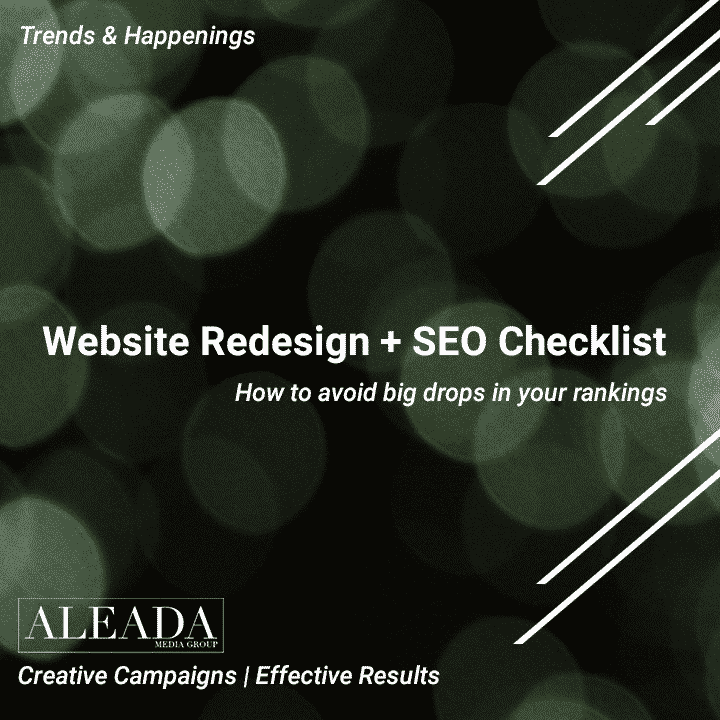Website Redesign + SEO Checklist

How to avoid big drops in your rankings.
If your website is no longer reaching its potential, then it might be time to look into redesigning your website. One case study found that a website redesign improved leads by 314 percent along with their SEO campaign.
Website redesigns can be costly but trust us, it’s a much better option than wasting money year after year with a website that’s inefficient.
When redesigning your website, it’s very important to avoid pitfalls that can hinder your SEO. Now let’s dive into a checklist that you must keep in mind to avoid losing rankings when redoing your site.
What exactly is a website redesign & does it really make that much of a difference?
A website redesign involves large-scale changes. During a redesign, elements of your code, content, structure, and visuals may change drastically giving your website a completely new look.
This is very important because 50% of consumers believe that website design and functionality is a direct representation of a company’s brand.
Benefits of a Website Redesign
Website redesigns aren’t without risk. The risk usually comes from an SEO standpoint. But when done right the redesign offers significant upside.
- Improve SEO and site performance
- Simplify the user experience
- Refocus your content strategy
- Give your site a facelift
- Offer faster load speeds
- Provide up to date security
The most obvious benefit is since your website serves as a modern-day shop front, you want to make it attractive.
Let’s think about this concept – If a physical store has a broken sign, poor lighting, and a dingy interior, it’s going to struggle to appeal to people. It’s the same exact thing for your company’s website. If it looks out of date, your visitors are going to wonder if your business is tired out and out of date as well.
A website redesign is much more than a facelift. It gives the opportunity to change the fundamental structure of your website and makes it easier for visitors to navigate. You want to start with the right approach since even doing a simple redesign with basic features can take an average of two months to complete.
Simple Rule:
When it comes to design and UX is that complicated design is rarely good. (It may look cool) But you want to make it as simple as possible for your visitors to navigate your site and find exactly what they’re looking for.
How to Know if a Website Redesign is Necessary?
Top Reasons:
- Low conversion rate
- High bounce rate
- Needs better UX
- Not responsive on all devices
- Outdated website
- No SEO-friendly
It can be tricky to know when a website redesign is necessary. Chances are you’re investing a good chunk of money into your new site so timing is everything.
One thing to remember is user experience (UX) It’s essential in digital marketing. It’s going to show in almost every metric and ultimately, it’s going to have an impact on your bottom line.
One of the best ways to know if it is time to make changes to your website is by putting yourself into somebody else’s point of view. Imagine you’re visiting your site for the first time, ask yourself the below questions.
- Does the branding seem on-point?
- Do pages load quickly?
- Is your site laid out in a logical way that’s easy to navigate?
- Are your pages optimized for mobile?
- Is it difficult to find the information you’re looking for?
- Is your customer journey streamlined enough?
Compare your website to your competitors and see how you stack up. If you find your site is good in certain areas but missing a few details in others, a website refresh might be the answer.
SEO Consideration Before Getting Started:
The top reason visitors leave a website is due to slow loading times. Page speed, directly and indirectly, affects SEO.
This website redesign SEO list will help you stay organized throughout the entire process and make sure you don’t miss anything important.
Audit Your Existing Content
Content powers many websites’ organic presence. SEO is all about the activity using content marketing, and many successful businesses are built off of it.
Update Information Architecture:
Over 60% of users report leaving a website due to bad navigation. Although website navigation and information architecture are different. Information architecture is about how you organize information in your sitemap. Navigation is how you organize your website.
Carefully Map URL Redirects:
In the beginning, we mentioned how website redesign SEO processes aren’t without risk. The greatest of those risk is the potential of losing a lot of hard work you put into building your organic profile.
A website redesign is going to change the structure of your entire site. Some pages will get moved, some will even get deleted.
The thing is, small changes can make a big difference in SEO land. As much as 60% of marketers say SEO and content marketing is their biggest source of leads.
Optimize The Content You’re Going To Keep:
After a new site design, audit your content. You should have a good idea of what content you plan on keeping. If you’ve put the time and effort into your audit. The cool thing about a website redesign is that it’s the perfect opportunity to refresh old content and give it a new lease of life. This process alone will increase organic traffic.
The Takeaway
There come a time when you not only need to but MUST redo your website and SEO. This is an important moment for your business, and it needs to be handled with care. A website redesign carries a lot of risks when it comes to SEO but, at the same time it can offer lots of rewards and the rewards will make all the difference.
Are you planning on redoing your website? Let us know by messaging us!
